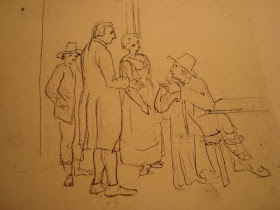 I came across this charming sketch by Tischbein recently in the "yearly report" of the Freies Deutsches Hochstift. It was acquired by the foundation in 1976 and has this annotation: "Johann Heinrich Wilhelm Tischbein, Goethe with His Landlord and Landlady in Rome, pen and ink drawing, 20.2 x 30 cm."
I came across this charming sketch by Tischbein recently in the "yearly report" of the Freies Deutsches Hochstift. It was acquired by the foundation in 1976 and has this annotation: "Johann Heinrich Wilhelm Tischbein, Goethe with His Landlord and Landlady in Rome, pen and ink drawing, 20.2 x 30 cm."Goethe, wearing a hat and a coat, sits at a table with three other people, gesturing with his left hand. The others seem to be listening carefully to what he is saying. The drawing suggests, according to the notes in the annual (1976, p. 444), not just an ordinary situation that Tischbein has decided to capture. Instead, it is an early stage of the famous portrait of Goethe (reproduced at the top of this blog). In his diary of 29 December 1786, Goethe noted that Tischbein seemed always to be studying him attentively. He soon learned why. At this stage there is no indication of the Italian scenery or Roman antiquity in the finished painting, but it already contains the idea that Goethe is a "traveler" or "wanderer."
The famous painting has been in Frankfurt since 1887, when it was given to the the Staedel Museum by Baroness von Rothschild.
The time is late afternoon or early evening. The place is the southeastern outskirts of Rome. The view is toward Rome, Frascati, and the distant, volcanic tumulus of the Alban Hills and takes in the tower tomb of Cecilia Metella, with the remains of the ancient city of Tusculum behind it and the ruins of a Roman viaduct to the right. I take these details from an article in the journal Monatshefte (80 [1988], pp. 187-99), by Rudolf M. Bisanz. As we know, the area was familiar to Goethe from his walking tours with Tischbein, especially along the ancient Via Appia Antica.
Bisanz's subject is the"eclecticism" of Tischbein's portrait. He obviously considers Tischbein a mediocre painter who nevertheless drew on various sources to produce the splendid painting. For instance, the half-recumbent, half-seated pose -- Goethe seems to be thinking, pondering, contemplating -- recalls the "Three Goddesses group" on the East Pediment of the Parthenon (but would Tischbein have see it?), the third-century Sleeping Ariadne in the Vatican, or even the poses on Etruscan sarcophagi.

Bersani also mentions contemporary portrait artists who might have influenced Tischbein: Gainsborough and Joseph Wright of Derby also pioneered "a type of portrait where the subject is posed informally, intimately, and naturally in an outdoor setting suggestive of relaxation, reverie, individualism, and spiritual union with nature." Bisanz goes to say that "a degree of melancholy, even morbidity, sometimes attaches itself to these statements of meditative introspection, especially with Wright."

Wright's subject here seems an ironic portrait of the influence of Jean-Jacques Rousseau. (See this interesting analysis of Wright's painting.) There is no sense of incipient Romanticism in Tischbein's portrait of Goethe. Tischbein clearly presaged the "classical" direction in which Goethe was heading.

Another painting tradition that may have influenced Tischbein is the pastoral, represented above by the painting of The Infant Jupiter with the Nymphs on Mount Ida, from 1650, by Nicolaes Berchem, now in The Wallace Collection, London. The profusion of sources in Tischbein's portrait do not take away from our admiration. It is unfortunate that so few contemporary artists have a knowledge of art history. They find it sufficient simply to "quote" from the works of other artists.
Ariadne picture credit: Brian McMorrow
No comments:
Post a Comment